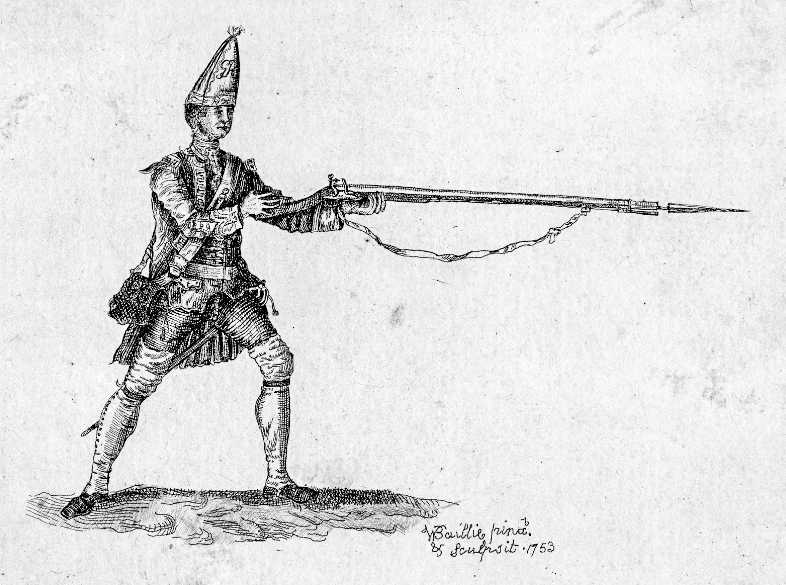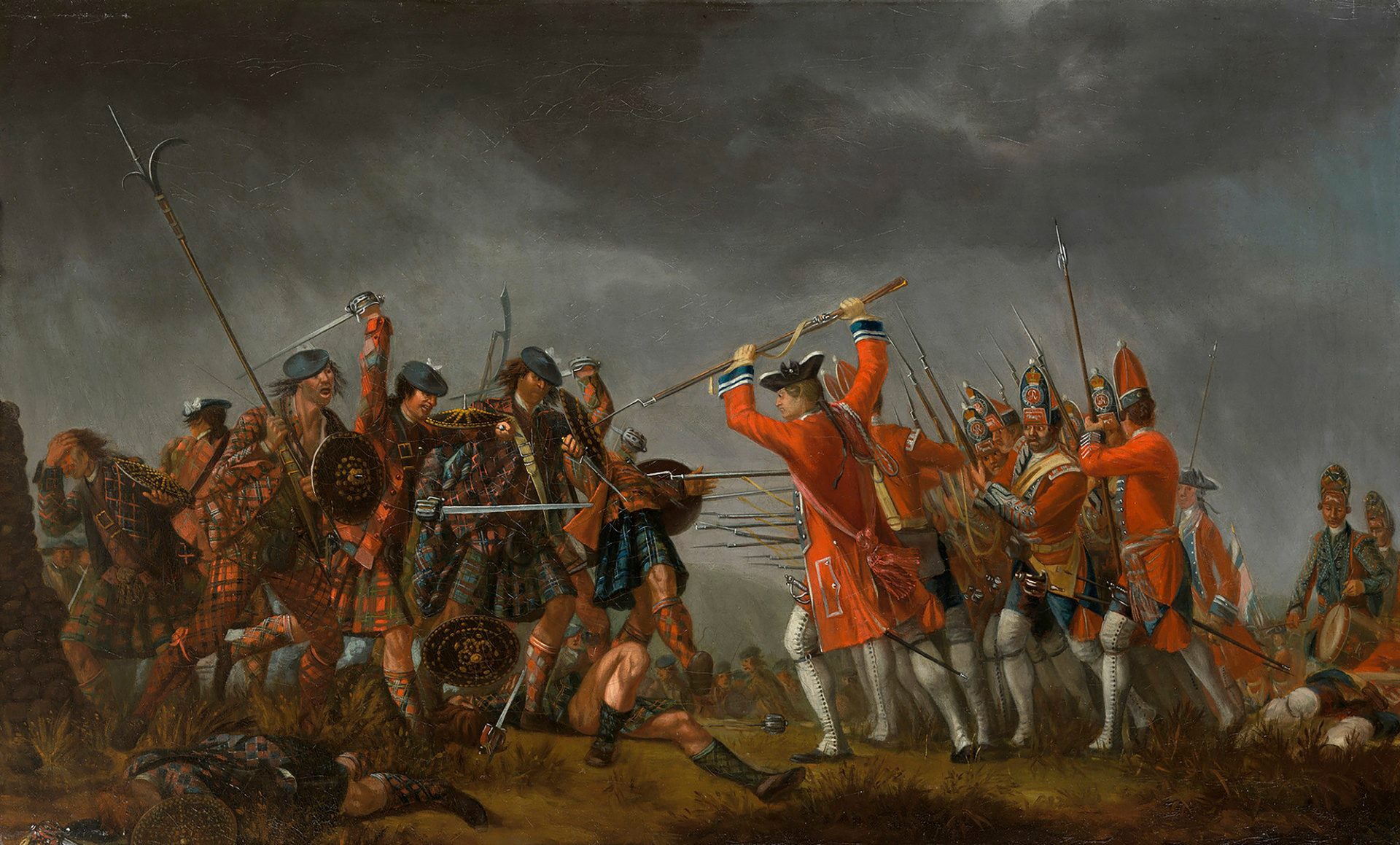No account of the battle of Culloden would be complete without mention of the Duke of Cumberland’s ‘new’ bayonet drill that was supposedly introduced to his infantry battalions while they were in camp in Aberdeen and Strathbogie prior to the final battle with the Jacobites on Culloden Moor in April 1746.
In a letter published in the April 1746 edition of The Scots Magazine, a soldier who claimed to have fought at Culloden under Cumberland mentioned a new method of using the bayonet to combat the Jacobite highlanders who were armed with sword and targe. This account of the battle and the innovative bayonet tactic has been retold in various histories of the battle ever since:
The next was, the direction given about the use of the bayonet. The alteration was mighty little, but of the last consequence. Before this, the bayonet-man attacked the sword-man right fronting him now the left-hand bayonet attacked the sword fronting his next right-hand man. He was then covered by the enemy’s shield where open on his left, and the enemy’s right open to him. This manner made an essential difference, staggered the enemy, who were not prepared to alter their way of fighting, and destroyed them in a manner rather to be conceived than told.1
Instead of engaging the man coming directly in front, each soldier would thrust his bayonet at the enemy bearing down on the soldier to his right. Each soldier, therefore, would have to rely on the man to their left to cover them. The tactic would be impractical on the battlefield. In the confusion of battle with a mass of Jacobite highlanders bearing down on them, it would be difficult for Cumberland’s men to know who to target and there was no guarantee that the Jacobites would arrive at the point of the bayonets to be obligingly skewered.
After reviewing the evidence and hearing from a reader who stated that no changes had been made in the use of the bayonet, the November 1746 edition of The Scots Magazine published a retraction of the earlier letter stating that: ‘We are likewise informed, that there is no foundation for what is said… of an alteration having been made in the manner of using the bayonet.’2
It is most likely that Cumberland did not introduce a new method for the bayonet but simply ordered his soldiers to undergo rigorous training in the standard bayonet drill to ensure they would have the confidence to stand and not panic when faced with a highland charge. By presenting a hedge of bayonets and thrusting them forward at chest height, the soldiers would have had an effective defence against any Jacobites who reached their lines.
The bayonet’s greater reach compared to the broadsword made it a valuable weapon in this situation. The key to success was the soldiers’ confidence in their training and their ability to stand together and prevent panic, as seen at Prestonpans and – to a lesser extent – Falkirk.
The highland charge was as much psychological as it was physical and was designed to instil terror in the opposing force causing them to break and run, with the fleeing soldiers cut down by the merciless blades of the highlanders. If the opposing side did not run and instead stood their ground then the charge would very likely fail.
The standard drill for charging and pushing the bayonet was laid down in Major-General Humphrey Bland’s 1743 edition of A Treatise of Military Discipline and was as follows:
Bring the Firelock strait up before you as in the Recover, with this Difference, that you must turn the Lock outward in the bringing of it up; tell 1, 2, hold the Firelock fast with the left Hand, and clap the Palm of the right on the Butt-end, the Thumb and Barrel pointing to the Right. Then tell 1, 2, fall back with the right Foot a moderate Pace, and in a direct Line behind the left, and at the same Time come to your Charge, by bringing down the Firelock to a Level, and supporting it with your left Arm by raiſing up your Elbow from your Body, the Stock lying between the left Thumb and Fore-finger, and the Butt-end in a full right Hand, the Thumb on the upper Part of it with the Barrel upwards, and the Bayonet pointing directly to the Front about Breast high. The right Knee must be kept stiff, and the Toe pointing directly to the Right; but the left Knee must bend a little forward, with that Toe to the Front.
Push your Firelock with both Hands strait forward, without raising or sinking the Point of the Bayonet, bringing the Butt-end before the left Breast; then tell 1, 2, and bring it back to its former Place.3
Daniel Hamilton a grenadier in Barrell’s regiment recalled the training that the infantry battalions went through while at Aberdeen and Strathbogie in March-April 1746: “the grenadiers attack the battalion, in exercising, with their broad swords, to, convince the men of the superiority of the bayonets”.4 He makes no mention of an alteration to the standard bayonet drill.

In testimony to the bayonet training, Barrell’s and Munro’s regiments on Cumberland’s left-wing at Culloden stood their ground when, due to the nature of the terrain, the main Jacobite assault fell upon them. With sheer weight in numbers the Jacobites “broke in between the grenadiers of Barrel and Monro; but these had given their fire according to the general direction, and then parried them with their screwed bayonets”.5 An account by a corporal in Munro’s regiment states: “the Front Rank charged their Bayonets Breast high, and the Centre and Rear Ranks kept a continual Firing”. Again there is no mention of a new bayonet technique being employed.
Barrell’s and Munro’s regiments fought the Jacobites in brutal hand-to-hand fighting before being supported by elements of Cumberland’s second line standing behind them. An eyewitness later stated that: “There was scarce a soldier or officer of Barrels, or of that part of Monro’s which engaged, which did not kill one or two men with their bayonets or spontoons.”6 Cumberland himself wrote three days after the battle: “our men fairly beat them back with their bayonets, and made a great slaughter of them.”7
An account of the battle written five days afterwards stated:
The Battle was so desperate, that the Soldiers Bayonets were stain’d and clotted with the Blood of the Rebels up to the Muzzles of their Muskets… General Barrel’s Regiment gain’d the greatest Reputation imaginable in the late Engagement, the best of the Clans having made their strongest Efforts to break them, but without Effect, for the old Tangierines bravely repulsed those Boasters, with a dreadful Slaughter, and convinced them that the Broad Sword and Target is unequal to their Musket and Bayonet, when in the Hands of Veterans, who are determined to use them. After the Battle there was not a Bayonet in the Regiment but was either bloody or bent.8
What Cumberland did introduce at Aberdeen was a modified platoon firing drill specifically developed to demolish the highland charge before it came to the use of cold steel. On 2 April 1746, he issued orders for the Royal Scots Fusiliers “to be out in the Park tomorrow at 11 o’clock there to practice the motions of alternate firings by platoons from ye right and left to ye centre reserving fire of ye front rank and Grenadiers.”9
Even if a new bayonet drill had been introduced it would have been impractical for another reason that is quite often overlooked. Before the battle, most of the Jacobite highlanders had discarded their targes and only a limited number were armed with broadswords. From the Jacobite dead and wounded which numbered around 1,500, less than 200 broadswords were recovered. While the clan gentry and officers standing on the front rank of the main Jacobite line would have wielded broadswords the vast majority of the Jacobites – highlanders and lowlanders – were armed with muskets.10
Notes:
- The Scots Magazine, 1746, vol 8, p. 192. ↩︎
- Ibid, p. 524. ↩︎
- Humphrey Bland, A Treatise of Military Discipline, 5th ed, London 1743; Bland served in Scotland under Cumberland. ↩︎
- Observations on Mr Home’s Account of the Battle of Culloden, 1802. ↩︎
- Andrew Henderson, The Life of William Augustus, Duke of Cumberland, 1766, p. 255 ↩︎
- The History of the Rebellion Raised Against His Majesty King George II, 1745, p. 44 ↩︎
- Letter from Cumberland to Lord Loudoun, 19 April 1746, Cumberland Papers, Royal Archives. ↩︎
- John Marchant, The History of the Present Rebellion, 1746, p. 397. ↩︎
- Nottingham University, Hallward Library, Galway Collection, GA 12835, quoted in: David Blackmore’s Destructive and Formidable: British Infantry Firepower 1642 – 1765, p. 111. ↩︎
- Return of Ordnance taken at Culloden, Cumberland Papers, Royal Archives. ↩︎
Cite this article: Ritchie, N. (24 January 2023). Duke of Cumberland’s ‘new’ bayonet drill. Scottish History. https://www.scottishhistory.org/articles/cumberlands-bayonet-drill/


